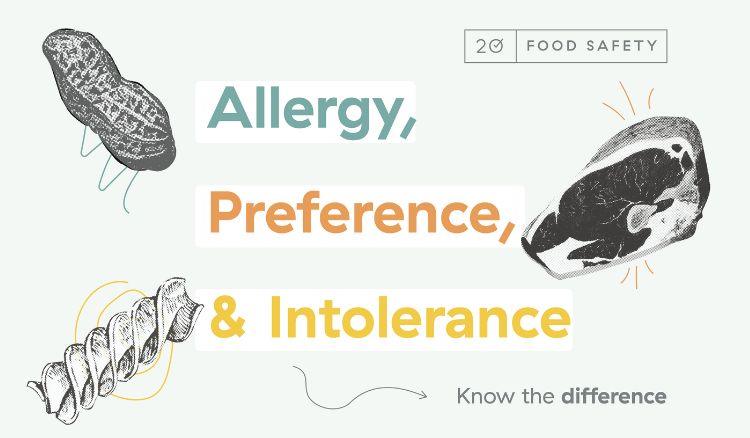Have you ever been taking an order and a customer at your table inquires, “Does this dish have gluten in it? It doesn’t agree with me.” If so you, like many others, have come in contact with someone who may have a food allergy. Or intolerance. Or preference.
As food industry professionals we may not be able to tell which of these dietary restrictions our diners experience in their lives, but it is our responsibility to do our best to accommodate their requests–and part of meeting their needs is understanding the differences between the three. These are the questions (and answers!) this piece will cover:
What is a food allergy?
According to the Mayo Clinic, a food allergy causes an immune system reaction affecting numerous organs in the body and produces a range of symptoms.1 An allergic reaction occurs when the body perceives a food to be a threat to the system, and symptoms can range from breathing problems to throat tightness and hoarseness, vomiting, abdominal pain, hives, and even life-threatening anaphylaxis.2 The Cleveland Clinic notes these symptoms can come on rapidly (within 30 minutes) or take a little longer to appear (up to two hours later).3 In the United States, there are nine major allergens that pre-packaged foods are required to call out on their ingredient lists–and many foodservice establishments choose to label them on their menus as well.
What is a food intolerance?
In contrast, a food intolerance means the body cannot properly digest a substance within a food, typically because of an enzyme deficiency.4 Other causes of food intolerances include irritable bowel syndrome, sensitivity to food additives, recurring stress or psychological factors, and Celiac disease.5 While the reactions associated with an intolerance are typically limited to digestive discomfort and are not life-threatening, they can be just as (if not more) unpleasant to experience.
What is a food preference?
A food preference is the specific, lifestyle avoidance of a certain food or food group with reasons spanning from religious beliefs, personal values, and individual tastes.6 Categories of food preferences include vegan, vegetarian, pescatarian, kosher, halal, paleo, keto, and beyond. While these preferences do not produce immune or digestive responses, the values that created these dietary preferences are often closely-held and carry great emotional weight for people.
There are many food safety myths that exist in our world, and just as many when it comes to handling modification requests from diners. One common misconception that allergies, intolerances, and preferences can be addressed in the same way, across all people–and that is simply not true. Variations in severity and adherence mean there is no one answer for how to thoughtfully accommodate the modifications diners ask for.
A clear understanding of the definitions of food allergies, intolerances, and preferences can make food industry staff more equipped to provide a safe and enjoyable experience to their customers. Trust20's suite of products includes Food Allergy Certificate Training. Knowledge is not just power in this circumstance, it's crucial to keep your customers safe!
Sources:
- Mayo Clinic: Food allergy vs. food intolerance: What's the difference?
- Kids Health: What's the Difference Between a Food Allergy and a Food Intolerance?
- Cleveland Clinic: Food Allergy vs. Intolerance: What’s the Difference?
- Medical News Today: Is it a food allergy or an intolerance?
- Mayo Clinic: Food allergy vs. food intolerance: What's the difference?
- Gaby Mora: Food allergy, intolerance, and preference






